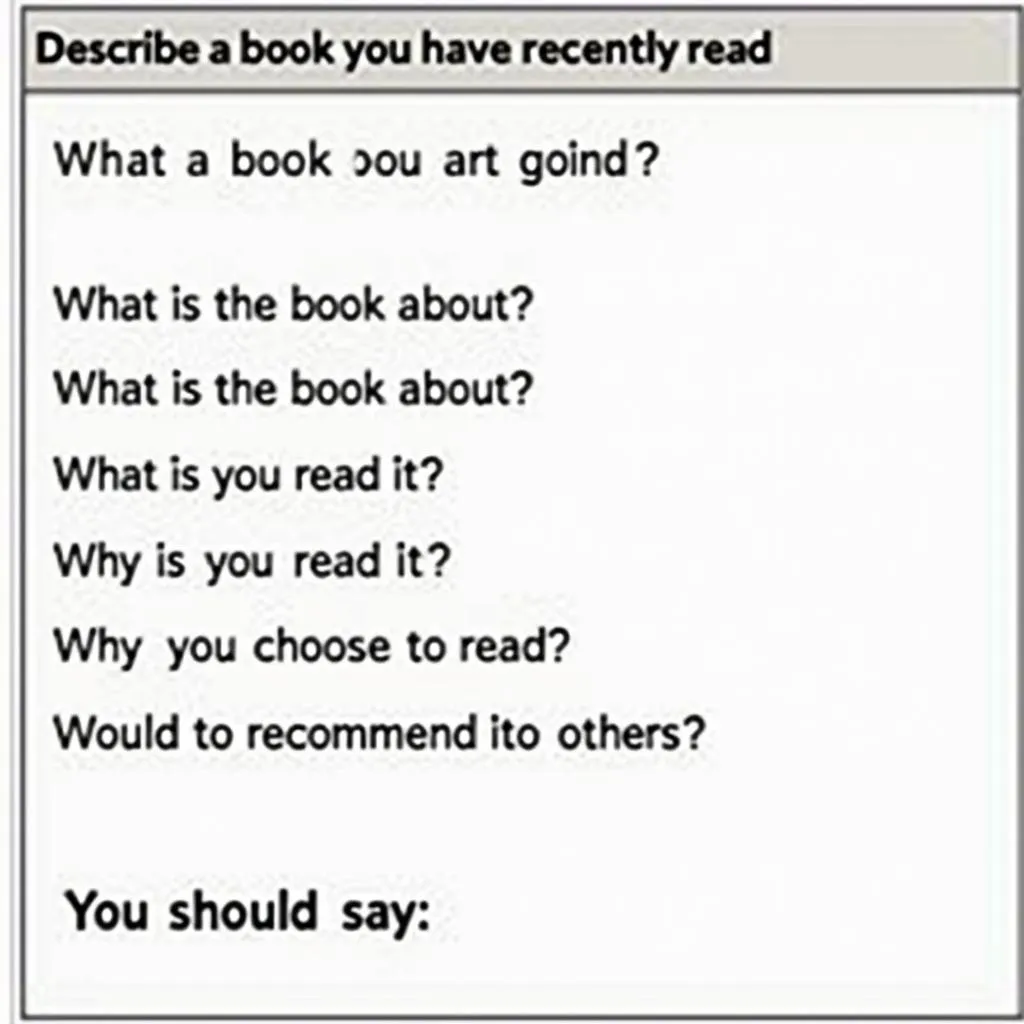Understanding IELTS Speaking Part 2 Cue Cards
IELTS Speaking Part 2, also known as the “long turn” or “cue card” section, is a crucial component of the IELTS Speaking test. In this part, candidates are given a topic card with prompts and are required to speak for 1-2 minutes on the given subject. Understanding how to effectively tackle these cue cards is essential for achieving a high score in the IELTS Speaking test.
What Are Cue Cards?
Cue cards are small cards containing a topic and several prompts or questions related to that topic. These prompts are designed to guide your speech and ensure you cover various aspects of the subject. Typically, a cue card will include:
- A main topic
- 3-4 bullet points with specific questions or areas to address
- A reminder to explain one or more of the points
 IELTS Speaking Part 2 Cue Card Example
IELTS Speaking Part 2 Cue Card Example
Strategies for Answering Cue Cards
1. Understand the Topic and Prompts
When you receive the cue card, take a moment to carefully read and understand the main topic and all the prompts. This will help you organize your thoughts and ensure you address all the required points.
2. Use Your Preparation Time Wisely
You are given one minute to prepare your answer. Use this time effectively:
- Quickly jot down key points for each prompt
- Think of relevant vocabulary and phrases
- Organize your ideas in a logical sequence
3. Structure Your Response
A well-structured response is crucial for clarity and coherence. Follow this basic structure:
- Introduction: Briefly introduce the topic
- Main body: Address each prompt in detail
- Conclusion: Summarize or give a final thought on the topic
4. Elaborate on Your Points
Don’t simply answer the prompts with short responses. Expand on each point with examples, reasons, or personal experiences. This demonstrates your ability to speak at length on a given topic.
 IELTS Candidate Answering a Cue Card
IELTS Candidate Answering a Cue Card
Tips for Success
1. Practice with a Variety of Topics
Familiarize yourself with a wide range of potential topics. Common themes include:
- Personal experiences
- Descriptions of people, places, or objects
- Past events or future plans
- Likes and dislikes
2. Develop Your Vocabulary
Expand your vocabulary related to common cue card topics. This will help you express your ideas more precisely and impressively.
3. Use Linking Words and Phrases
Incorporate linking words and phrases to improve the flow of your speech. Examples include:
- “First of all…”
- “In addition to that…”
- “On the other hand…”
- “To conclude…”
4. Manage Your Time
Keep an eye on the time to ensure you cover all points within the allotted 1-2 minutes. If you finish early, elaborate on your points or add a thoughtful conclusion.
5. Stay Calm and Confident
Remember, it’s normal to feel nervous. Take deep breaths and speak at a steady pace. If you make a mistake, simply correct yourself and continue.
Common Mistakes to Avoid
-
Not addressing all prompts: Ensure you cover all the points mentioned on the cue card.
-
Speaking for too long or too short: Aim to speak for the full 1-2 minutes, but don’t go significantly over time.
-
Memorizing pre-prepared answers: Examiners can easily detect memorized responses. Focus on being natural and spontaneous.
-
Using overly complex language: While it’s good to showcase your vocabulary, using unnecessarily complicated words can hinder clarity.
-
Deviating from the topic: Stay focused on the given topic and prompts. Avoid going off on unrelated tangents.
Practice Exercises
To improve your performance in IELTS Speaking Part 2, try these exercises:
-
Timed practice: Use a stopwatch to practice speaking for exactly 2 minutes on various topics.
-
Record yourself: Record your responses and listen back to identify areas for improvement.
-
Peer practice: Practice with a study partner, taking turns as the speaker and the examiner.
-
Topic brainstorming: Regularly brainstorm ideas for common cue card topics to build your idea bank.
By following these strategies and consistently practicing, you can significantly improve your performance in IELTS Speaking Part 2. Remember, the key to success lies in preparation, structure, and confident delivery. Good luck with your IELTS preparation!

